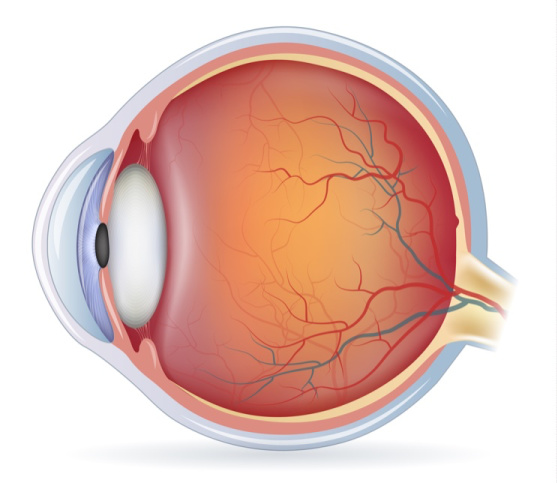Macular Drusen
Macular drusen are one of the first symptoms of age related macular degeneration (AMD). Drusen are small, yellow deposits that accumulate in the macula, which is the part of the retina responsible for sharp, central vision.
Drusen are composed of cellular waste products and can be seen by your eye care professional during an eye examination as small yellow spots. This is what they look like.
They are often found in those 60 and older.
Some links in the following sections are eBay or Amazon affiliate links, which means that if you purchase a product through them I receive a small commission. There is no extra cost to you. Find more details on this page.
Number and Size Matters
When there is an increase in the size or number of drusen a person's risk of developing either advanced dry AMD or wet AMD increases.
There are three stages of age related macular degeneration.
1) Early AMD
√ Several small drusen or a few medium-sized drusen
√ No other symptoms
√ No vision loss
2) Intermediate AMD
√ Have either many medium-sized drusen or one or more large drusen
√ May see a blurred spot in the center of their vision.
√ Need more light for reading and other tasks
3) Advanced AMD
√ Has several medium size to large size drusen,
√ The photoreceptor cells are degenerating as are the layers of tissue that feed and nourish the macula
√ Blurred spot in the center of your vision that gradually gets bigger and darker
√ Increased difficulty in reading or recognizing faces
Hard and Soft Macular Drusen
There are two types of macular drusen - hard and soft.
The hard form is the less harmful one and very commonly seen in aging eyes.
- Hard Drusen These are small, round, and well-defined deposits. Hard drusen are often considered a normal part of the aging process and may not cause significant vision problems on their own. However, their presence can be an indication of an increased risk for developing AMD.
- Soft Drusen These are larger and more irregularly shaped deposits. Soft drusen are associated with early and intermediate stages of AMD. They can lead to damage and degeneration of the macula, causing gradual central vision loss.
The soft form is more often associated with loss of vision.
According to Dr. James C. Folk, author of Protect Your Sight: How to Save Your Vision in the Epidemic of Age-Related Macular Degeneration:
" eyes with large drusen go on to develop severe AMD with vision loss much more often than eyes with small drusen. The size of the drusen is a more important prognostic sign than the number of drusen."
Next time you are having an eye exam ask your eye care specialist if you have macular drusen and ask about the size, the number and if they appear to be hard or soft.
What Causes Macular Drusen?
Dr. Michael Cooney, a vitreoretinal surgeon with Vitreous Retina Macular Consultants of New York, explains that drusen and subretinal drusenoid deposits are thought to occur as a result of three factors:
- Chronic inflammation
- Accumulation of waste products in the retina
- Damage to the retinal pigment epithelium (RPE) cells that support the retina.
Prevent, Slow Down or Reverse AMD
If your eye doctor has just discovered macular drusen in your yearly eye exam, you may want to find out what you can do to make any changes in your diet and lifestyle to help take better care of your eyes.
Dr. Michael A. Samuel, the author of Macular Degeneration: A Complete Guide for Patients and Their Families states,
"Early, dry AMD can be prevented, slowed, and even reversed with diet and lifestyle changes. In its early stages, progression to blindness can be prevented with appropriate nutritional interventions."
Click here to learn more: Macular Degeneration Prevention.
At your next eye exam ask your eye doctor these four important questions if you have macular drusen...
1. Are the drusen in both eyes or in one eye?
2. What type of drusen are they - hard or soft?
3. How many drusen do you see?
4. How large are the drusen? Are they considered small or large?
It is important to get regular eye exams, especially as you age, to ensure that if symptoms like macular drusen occur, they can be diagnosed and monitored along with tips on how to possibly reduce or slow down their progression.
DISCLAIMER:
The information on our website and newsletters are not intended as, and shall not be understood or construed as, medical or health advice. The information contained on these platforms is not a substitute for medical or health advice from a professional who is aware of the facts and circumstances of your individual situation.
Go Back to Macular Degeneration Symptoms
Return to WebRN Macular Degeneration Home
√ Prevention of Macular Degeneration?
√ Tips for Daily Living?
√ Food Suggestions for a Macular Degeneration Diet?
√ Ideas on Visual Aids to Maximize your Sight?
If you said "yes" to any of the above, sign up for the monthly Macular Degeneration News.




